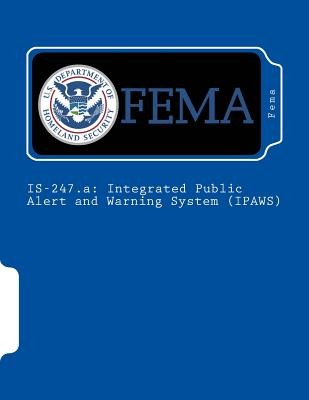
- We will send in 10–14 business days.
- Author: Fema
- Publisher: CreateSpace Independent Publishing Platform
- ISBN-10: 1984056492
- ISBN-13: 9781984056498
- Format: 21.6 x 28 x 0.2 cm, minkšti viršeliai
- Language: English
- SAVE -10% with code: EXTRA
Reviews
Description
Course Overview This course provides basic information on the Integrated Public Alert and Warning System (IPAWS). The goal of this course is to provide authorized public safety officials with: increased awareness of the benefits of using IPAWS for effective public warnings; skills to draft more appropriate, effective, and accessible warning messages; and best practices in the effective use of Common Alerting Protocol (CAP) to reach all members of their communities. This course consists of the following lessons: -Lesson 1: Introduction to IPAWS -Lesson 2: Appropriate, Effective, and Accessible Alert and Warning Messages -Lesson 3: Common Alerting Protocol Message Composition Course Objectives: Upon completion of this course, participants will be able to: -Define Integrated Public Alert and Warning System (IPAWS). -Identify the benefits of using IPAWS for generating warnings. -Describe IPAWS operation. -Identify the basis for determining who is authorized to send IPAWS alert and warning messages. -Apply criteria for sending appropriate alert messages. -Identify the components of effective alert and warning messages. -Apply criteria for creating accessible alert and warning messages. -Describe factors that influence public response to warning messages. -Discuss the myths associated with public response to warning messages. -Define CAP. -Identify some of the commonly used CAP elements and their associated values. -Identify how a CMAS message is mapped from CAP. Primary Audience This course is designed for emergency managers, law enforcement officials, fire department personnel, dispatch personnel (911), National Weather Service (NWS) personnel, and other authorized centers (according to a State's EAS plan, State emergency plan, Amber Plan/Amber Alert).
- Author: Fema
- Publisher: CreateSpace Independent Publishing Platform
- ISBN-10: 1984056492
- ISBN-13: 9781984056498
- Format: 21.6 x 28 x 0.2 cm, minkšti viršeliai
- Language: English English
Course Overview This course provides basic information on the Integrated Public Alert and Warning System (IPAWS). The goal of this course is to provide authorized public safety officials with: increased awareness of the benefits of using IPAWS for effective public warnings; skills to draft more appropriate, effective, and accessible warning messages; and best practices in the effective use of Common Alerting Protocol (CAP) to reach all members of their communities. This course consists of the following lessons: -Lesson 1: Introduction to IPAWS -Lesson 2: Appropriate, Effective, and Accessible Alert and Warning Messages -Lesson 3: Common Alerting Protocol Message Composition Course Objectives: Upon completion of this course, participants will be able to: -Define Integrated Public Alert and Warning System (IPAWS). -Identify the benefits of using IPAWS for generating warnings. -Describe IPAWS operation. -Identify the basis for determining who is authorized to send IPAWS alert and warning messages. -Apply criteria for sending appropriate alert messages. -Identify the components of effective alert and warning messages. -Apply criteria for creating accessible alert and warning messages. -Describe factors that influence public response to warning messages. -Discuss the myths associated with public response to warning messages. -Define CAP. -Identify some of the commonly used CAP elements and their associated values. -Identify how a CMAS message is mapped from CAP. Primary Audience This course is designed for emergency managers, law enforcement officials, fire department personnel, dispatch personnel (911), National Weather Service (NWS) personnel, and other authorized centers (according to a State's EAS plan, State emergency plan, Amber Plan/Amber Alert).


Reviews